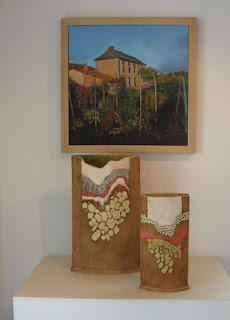





For the last five years Sam Garness has been developing the garden/estate at Bevere Knoll, a fine Georgian family residence, on the outskirts of Worcester and adjacent to ‘The Gallery at Bevere’ a converted coach house, stable and chicken house. She trained at Pershore College gaining an RHS Certificate, National Award in Garden Design and an HNC in Professional Gardening. Alongside me, the owner of Bevere Knoll, they have been working with the gallery’s exhibitions team to put together the 2009 ‘Gallery in the Garden Show’.
Part of the garden was recently fenced off which enables the Gallery at Bevere to hold a sculpture trail through this acre of old shrubs, canopy of laurels and mature trees including a large oak with a lovely spreading habit. This, in the spring has an abundance of wild daffodils and crocus growing underneath it and here also stands a ‘flock of sheep’ (ceramic).
An impressive dead oak, where two very old gravestones stand underneath dedicated to ‘old faithful’ has a Solanum and Rosa Paul’s Himalayan Musk growing up. This part of the garden is now in a semi wild state, wild flowers have been planted under the oak, which was done in an experimental way by placing cardboard over the grass, soil over this and then planting plugs into the soil, which hopefully will allow the plugs to establish before the grass and weeds grow through. We wait with bated breath.
Originally an old apple tree stood in the centre of the grass, which fell down two years ago for no apparent reason! I like to replace a tree when one has gone so several unusual specimens have been planted on the edge of woodland around the lawn area. -
A ‘grassery ‘ has also been planted, but due to difficulties with moles some of the grasses have been lost, so they are to be replaced this year. Among these grasses stands a fabulous ancient ‘Judas Tree’ (Cercis siliquastrum) and located on the side of the drive there is a very fine example of ‘Weeping Holly’ which is thought to be at least a l00 years old.
Yew trees frame small areas of the owner’s private garden allowing glimpses through to the flower borders and more manicured lawn with palms and a fig tree bordering a large pond, which is home to very large ghost carp.
The sculptures are sympathetically sited around. On the trail, some ‘hidden’ in the atmospheric laurel woods, some in full resplendence on the lawns and amongst the bushes.
Whether professional or amateur gardener, the Gallery in the Garden has plenty to inspire and excite - a winning marriage of nature and man made delights.
We are looking forward to June when the garden opens again.
The Gallery and Garden Sculpture Trail
Saturday 6th June – Sunday 30th August
An exhibition and sale of garden sculptures




